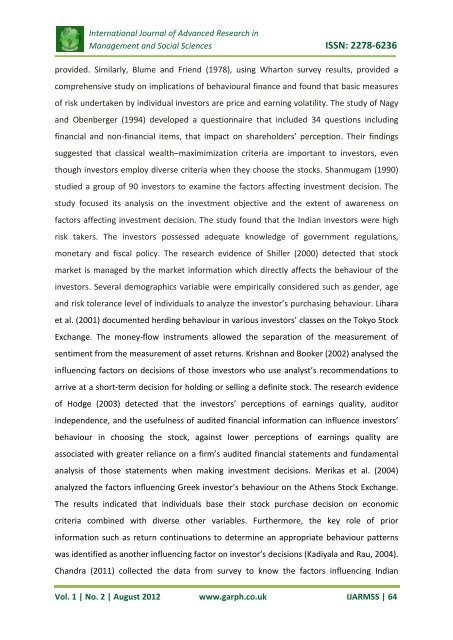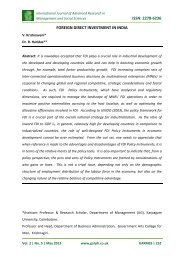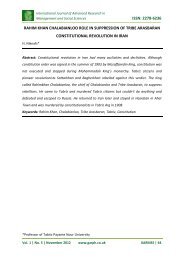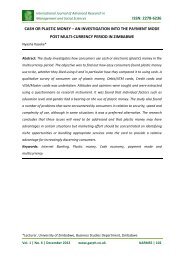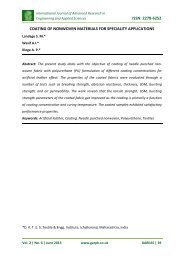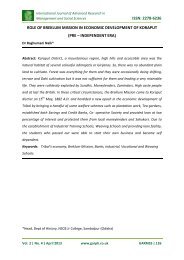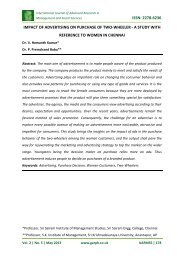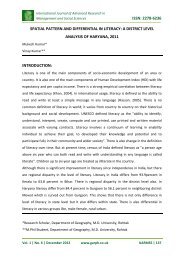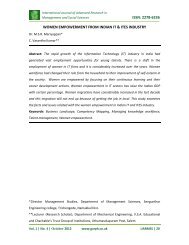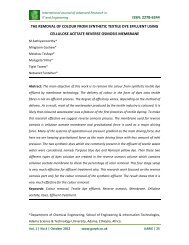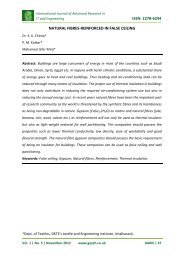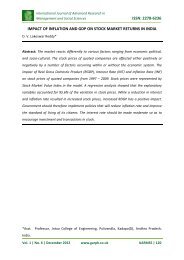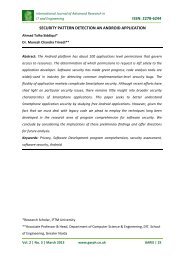issn: 2278-6236 small investor's behaviour on stock ... - Garph.co.uk
issn: 2278-6236 small investor's behaviour on stock ... - Garph.co.uk
issn: 2278-6236 small investor's behaviour on stock ... - Garph.co.uk
Create successful ePaper yourself
Turn your PDF publications into a flip-book with our unique Google optimized e-Paper software.
Internati<strong>on</strong>al Journal of Advanced Research in<br />
Management and Social Sciences ISSN: <str<strong>on</strong>g>2278</str<strong>on</strong>g>-<str<strong>on</strong>g>6236</str<strong>on</strong>g><br />
provided. Similarly, Blume and Friend (1978), using Whart<strong>on</strong> survey results, provided a<br />
<strong>co</strong>mprehensive study <strong>on</strong> implicati<strong>on</strong>s of <str<strong>on</strong>g>behaviour</str<strong>on</strong>g>al finance and found that basic measures<br />
of risk undertaken by individual investors are price and earning volatility. The study of Nagy<br />
and Obenberger (1994) developed a questi<strong>on</strong>naire that included 34 questi<strong>on</strong>s including<br />
financial and n<strong>on</strong>-financial items, that impact <strong>on</strong> shareholders’ percepti<strong>on</strong>. Their findings<br />
suggested that classical wealth–maximimizati<strong>on</strong> criteria are important to investors, even<br />
though investors employ diverse criteria when they choose the <strong>stock</strong>s. Shanmugam (1990)<br />
studied a group of 90 investors to examine the factors affecting investment decisi<strong>on</strong>. The<br />
study focused its analysis <strong>on</strong> the investment objective and the extent of awareness <strong>on</strong><br />
factors affecting investment decisi<strong>on</strong>. The study found that the Indian investors were high<br />
risk takers. The investors possessed adequate knowledge of government regulati<strong>on</strong>s,<br />
m<strong>on</strong>etary and fiscal policy. The research evidence of Shiller (2000) detected that <strong>stock</strong><br />
market is managed by the market informati<strong>on</strong> which directly affects the <str<strong>on</strong>g>behaviour</str<strong>on</strong>g> of the<br />
investors. Several demographics variable were empirically c<strong>on</strong>sidered such as gender, age<br />
and risk tolerance level of individuals to analyze the investor’s purchasing <str<strong>on</strong>g>behaviour</str<strong>on</strong>g>. Lihara<br />
et al. (2001) documented herding <str<strong>on</strong>g>behaviour</str<strong>on</strong>g> in various investors’ classes <strong>on</strong> the Tokyo Stock<br />
Exchange. The m<strong>on</strong>ey-flow instruments allowed the separati<strong>on</strong> of the measurement of<br />
sentiment from the measurement of asset returns. Krishnan and Booker (2002) analysed the<br />
influencing factors <strong>on</strong> decisi<strong>on</strong>s of those investors who use analyst’s re<strong>co</strong>mmendati<strong>on</strong>s to<br />
arrive at a short-term decisi<strong>on</strong> for holding or selling a definite <strong>stock</strong>. The research evidence<br />
of Hodge (2003) detected that the investors’ percepti<strong>on</strong>s of earnings quality, auditor<br />
independence, and the usefulness of audited financial informati<strong>on</strong> can influence investors’<br />
<str<strong>on</strong>g>behaviour</str<strong>on</strong>g> in choosing the <strong>stock</strong>, against lower percepti<strong>on</strong>s of earnings quality are<br />
associated with greater reliance <strong>on</strong> a firm’s audited financial statements and fundamental<br />
analysis of those statements when making investment decisi<strong>on</strong>s. Merikas et al. (2004)<br />
analyzed the factors influencing Greek investor’s <str<strong>on</strong>g>behaviour</str<strong>on</strong>g> <strong>on</strong> the Athens Stock Exchange.<br />
The results indicated that individuals base their <strong>stock</strong> purchase decisi<strong>on</strong> <strong>on</strong> ec<strong>on</strong>omic<br />
criteria <strong>co</strong>mbined with diverse other variables. Furthermore, the key role of prior<br />
informati<strong>on</strong> such as return c<strong>on</strong>tinuati<strong>on</strong>s to determine an appropriate <str<strong>on</strong>g>behaviour</str<strong>on</strong>g> patterns<br />
was identified as another influencing factor <strong>on</strong> investor’s decisi<strong>on</strong>s (Kadiyala and Rau, 2004).<br />
Chandra (2011) <strong>co</strong>llected the data from survey to know the factors influencing Indian<br />
Vol. 1 | No. 2 | August 2012 www.garph.<strong>co</strong>.<strong>uk</strong> IJARMSS | 64


